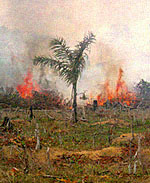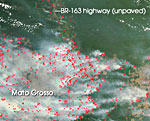在连续三年下降后,巴西亚马逊的森林清理在2007年的最后五个月中急剧上升,一年前同期几乎翻了一番。这一增长主要归因于全球商品的繁荣,这一措施破灭了,希望最近的保护计划和执法努力最终从该地区的发展利益中夺取了对雨林的控制。
它还暗示了全球化和经济增长将在世界上最大的雨林的命运中发挥作用的日益增长。中国,印度,东南亚,俄罗斯和巴西本身的飞涨经济正在助长国际对农产品的需求,这有助于巴西亚马逊的稳定退化。如果没有受到检查,这种商品驱动的发展 - 与先前的伐木,农业定居点以及大规模的变化(例如火灾和干旱)相结合,预计将导致一半以上的亚马逊在接下来的20日被记录,燃烧或退化。根据最近的研究。考虑到气候变化的影响(预计将干燥亚马逊的干燥部分)在该地区的损失可能会更糟。

从历史上看,亚马逊已被证明对气候变化,哥伦比亚前人口的人体干扰,甚至在千禧年厄尔米尼诺般的事件期间发生的火灾和极端干旱的韧性。然而,目前对影响亚马逊的力量的猛击是前所未有的。该地区从未经历过大规模森林丧失和退化,分裂,火灾和全球变暖的同时影响。许多科学家和保护主义者非常担心,不仅是因为造成森林破坏的生物多样性的丧失,而且还因为这种庞大的碳储存库的切割和烧毁会进一步加热一个已经以令人震惊的速度变暖的星球。188金博网注册就送188
“Amazon deforestation releases vast quantities of greenhouse gases,” said Philip M. Fearnside, research professor at the National Institute for Research in the Amazon in Manaus, Brazil. “Unlike other tropical areas in the world that are also undergoing rapid deforestation, Amazonia could release much larger amounts of gases in the future because there is still so much forest left to clear. This is part of a vicious cycle set in motion by global warming, especially because of its role in triggering more-damaging El Niño events. These cause Amazon forest trees to die from drought and fire, releasing gases that lead to more warming and still more dead trees. Emissions from dying trees and warming soils could contribute to a runaway greenhouse effect.”
巴西亚马逊森林砍伐的司机
与1970年代不同,当时森林砍伐经常与政府资助的发展计划相关联,该计划促进了生存农民的殖民化,巴西亚马逊的土地利用变化今天以大规模的工业农业和牛群的大规模转换为主导。亚马逊作为“绿色沙漠”的概念(几乎不值得清理和发展)是过去的事。如今,巴西人将亚马逊视为南美的下一个农业边界,这是美国心脏地带的竞争对手,它将在世界各地的桌子上将燃油和食物燃料储备。This transition — with its profound implications for the future of the Amazon — has been made possible by infrastructure expansion, the near eradication of foot-and-mouth disease in cattle, and agricultural innovation that has converted the region’s poor acidic soils into land suitable for extensive soy farms.
随着它成为一个主要的农业区,亚马逊发现其命运与全球粮食和生物燃料市场越来越紧密,价格上涨为森林清理提供了动力。许多因素为燃烧和土地清理提供了尖峰。其中包括国际对农业订书钉的需求不断增长的商品价格的最新升级;在发展和新兴市场中攀登肉类消耗,这是对谷物作为饲料的需求;并激发了对生物燃料的兴趣,这是由创纪录的高油价和美国玉米乙醇补贴提供的。巴西农业扩张的另一项催化剂是一项430亿美元的计划,称为Avanca Brasil(Forward Brazil),它是资助道路,港口,管道,水力发电水坝和其他基础设施在亚马逊及其周围及其周围的基础设施改进。

Brazilian satellite data from late 2007 show a marked increase in the number of fires and deforestation in the key soy and cattle-producing states of Pará and Mato Grosso. Both experienced increases in forest loss of 50 percent or more over the same period in 2006, coupled with a large jump in burning — in the case of Mato Grosso, a spike of more than 100 percent. The 123,000 fires detected across the Brazilian Amazon by the Terra and AQUA satellites are the most since such measurements began in 2003. Deforestation in the last five months of 2007 was expected to exceed 7,000 square kilometers, an area more than twice the size of Rhode Island.
Politics and economics, both in Brazil and abroad, are playing a key part in agricultural expansion in the Amazon. U.S. energy policy, which grants generous subsidies for corn ethanol, has effectively discouraged American farmers from growing soybeans, promoting the crop’s expansion in Brazil.
史密森尼热带研究所的研究员,2007年12月发表的信的作者,威廉·劳伦斯(William F. Laurance)博士说:“我们正在看到玉米[乙醇]与亚马逊森林砍伐的联系。”Science就此主题而言。
“We see soy prices going up partly because less soy is being grown in the U.S. as corn expands to meet the surging demand for the emerging ethanol industry,” added Dr. Daniel Nepstad, director of the Woods Hole Research Center’s Amazon program in Belém, Brazil. “Similarly, as sugar cane expands in southern Brazil, soy production is heading northward, encroaching on the Amazon.”
尽管亚马逊的主要大豆种植者目前正在观察大豆新清算的两年暂停,但在邻近的塞拉多地区不存在暂停的暂停,这是一个稀树草原生态系统,其速度比亚马逊雨林的速度快三倍。随着大豆和甘蔗(巴西乙醇的来源)将其面积扩大到塞拉多,他们与牛牧场竞争,牛牧场是该地区农业用地的主要形式。与工业农业相比,低强度的牧场的每公顷收入明显少得多,然后流入边境地区,增加了森林砍伐。将土地卖给大豆和拐杖种植者的牧场主可以在边境购买10倍的土地。
随着对生物燃料的需求不断增长,油棕很有可能成为亚马逊的主要作物 - 考虑到种植油棕榈种植园一直是最近破坏巨大地区的驱动力,这是一种不祥的发展。印度尼西亚和马来西亚的雨林。科学家估计,巴西拥有230万平方公里的森林土地,适合油棕,等于有利于大豆和糖生产的森林地区。
由于Avanca Brasil计划资助的众多公路项目,将这些农产品推向市场,这是对亚马逊发展的障碍。将亚马逊核心与秘鲁的太平洋港口联系起来的跨科亚高速公路的改善有望刺激进一步的农业扩张。诸如Transoceanic之类的道路为伐木工人,土地投机者,牧场主,农民和殖民者提供了前往其他偏远地区的机会。这些经济利益,尤其是农业工业和伐木部门,然后建立“非官方”的刺激道路,为发展开辟了更多的森林。
协同威胁
As global demand grows for agricultural commodities produced in the Amazon, the region is being increasingly buffeted by drought, fragmentation, and forest fires, all of which are exacerbated by climate change. The synergistic impact of these forces raises the biggest questions for the future of Amazonia.
意识到气候变化的强大影响,科学家正在努力了解其对地球最大的雨林的潜在影响。一些模型表明,亚马逊的一部分将经历升高的温度和更少的降雨,而其他地区则会降雨,但是当预测该地区生态系统对全球变暖的敏感性时,辩论远非如此。
What little is known about current change in the Amazon is worrisome. Giant clearings suck moisture from surrounding forest fragments and allow winds to blow down trees, thinning the canopy and enabling sunlight to reach the forest floor. This dries leaf litter and kills trees. Dying trees drop leaves and branches, creating tinder for knee-high surface fires that spread to the forest from nearby agricultural clearings. While these fires are small, they cause significant damage in an ecosystem not well adapted to fire.
“尽管这些大火看起来相对无害,但实际上它们是非常破坏性的,因为大多数雨林树的热量都低。”“而且它们的慢速意味着火焰长时间与树木保持接触。结果,即使是低强度的火灾也会杀死多达40%的树木。”
随着植被烟雾的上升,森林自身的生产能力降低了 - 亚马逊某些地区的水分一半是通过蒸散液回收的。较少的树木意味着减少降雨量,而燃烧的大烟会抑制云形成并减少降雨量。这些影响不仅限于巴西。杜克大学罗尼·阿维萨尔(Roni Avissar)领导的研究表明,亚马逊的变化可能会产生更广泛的影响,从而影响了从墨西哥到德克萨斯州的降雨模式。
A 2003 simulation by Peter Cox and his colleagues at the Hadley Centre for Climate Prediction and Research provoked alarm and controversy when it forecast significant “dieback” of the Amazon rain forest by mid-century and a virtual collapse of the ecosystem by 2100. The projection, which evaluated only the impact of increased atmospheric carbon dioxide concentrations on temperature and precipitation in the region, has since been eclipsed by models forecasting an even more accelerated path due to interaction of climate and land-use change.
写入皇家学会的哲学交易bearlier this year, Daniel Nepstad and colleagues predicted that 55 percent of Amazon forests will be “cleared, logged, damaged by drought, or burned” in the next 20 years if deforestation, forest fires, and climate trends continue apace. The damage will release 15 to 26 billion tons of carbon into the atmosphere, adding to a feedback cycle that will worsen both warming and forest degradation in the region. Nepstad says this scenario is a conservative one — forest loss and emissions could be far worse.
他说:“直到本世纪末的哈德利模型(点),亚马逊将有一个大森林死亡。”“但是,在全球变暖开始之前,我们已经看到的干旱以及森林砍伐,伐木以及该政权一部分的火灾将会造成各种各样的破坏。”
尼普斯塔德和其他科学家指出了2005年的干旱,这是亚马逊可能朝着的方向前进的方向。这种干旱最近与热带大西洋而不是厄尔尼诺现象有关,这是记忆中最糟糕的。随着河流干燥,偏远社区被隔离,商业放缓到了停顿。数千平方公里的土地燃烧了几个月,将超过1亿吨的碳释放到大气中。
虽然似乎不可避免地会燃烧亚马逊的大部分时间,为牛牧场和工业大豆农场耕作,或者因气候变化而变成了稀树草原,但新兴趋势表明,有理由相信亚马逊可以避免最坏的情况。在未来的困扰中,由于对全球变暖和国际经济的大规模转变的迫在眉睫的影响不确定,正是这些驱动因素可以保留亚马逊救赎的关键。
如果世界上主要的工业化大国最终同意每年对数十亿吨大气中的数十亿吨温室气体定价,那么它可能会为创新的保护措施奠定基础,以帮助在十年内将亚马逊森林砍伐带来森林砍伐。在一项重大主动行动下,称为Redd(减少森林砍伐和森林退化的排放),私人投资者和政府都将向巴西支付巴西和亚马逊人民,不要记录或燃烧雨林。雷德市场将由工业和国家的需求驱动,以抵消其温室气体排放,通过支付其他人来保存其吸收碳的森林。对REDD项目的支持正在增长,因为很明显,仅传统的保护措施就不足以减慢亚马逊的持续破坏。